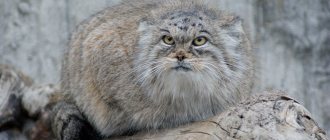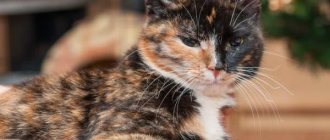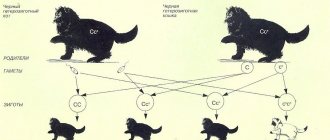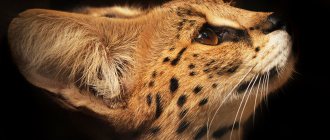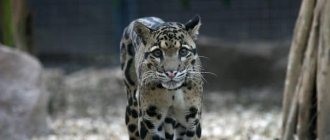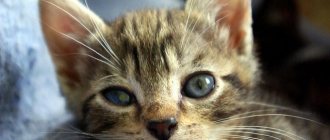Felines (lat. Felidae) is the name of a family of mammals from the order of carnivores, which includes both the domestic musk and the natural killer - the leopard. The cat family is divided into 2 subfamilies: small cats (lat. Felinae) and big cats (Pantherinae), the main difference is the ability of big cats to growl.
Depending on their habitat, felines change in size: from a miniature spotted red one weighing 1 kg to giants - a tiger and a lion, whose weight reaches 300 kg.
The coat color of different species of the cat family is striking in its diversity - from the almost white snow leopard to the bright orange golden cat and the deep black color of the black panther. The pattern comes in several varieties: spots, stripes and ticking.
The pattern is individual for each animal - it’s like a human fingerprint.
The method of hunting unites all types of cats - stalking the prey, sneaking and one effective jump. Apart from the cheetah, cats are not the best runners; if they fail to knock down the victim the first time, many of them leave to look for easier prey.
The claws of most individuals, except the cheetah and the Sumatran cat, are retractable. Cats' heads appear shorter and rounder than those of other carnivores due to fewer teeth. The tongue is covered with small pointed horny papillae, this helps to care for the fur and scrape meat from the bones of the victim.
The length of the fur and the amount of down differ depending on the climate of the species' distribution area: northern cats and those living in the mountains have longer and fluffier fur.
Continuation of the family line
Small cats breed annually or more often, depending on the length of daylight hours, large cats give birth once every 2...3 years.
The duration of gestation for kittens is from 64 to 78 days. The number of kittens in small cats can be up to 5...6, large cats bring 2..4 kittens.
Little kittens are helpless and blind; their mother takes care of them and teaches them hunting skills. The father almost never takes part in their lives.
The kitten stays with its mother for up to 8-12 months, then goes off to search for its hunting territories. At 12 months for small cats and 2 years for big cats, puberty begins.
Wild cat breeds
Most people are accustomed to domestic, fluffy creatures, but among their wild counterparts they can only name the most basic ones, such as a lion, a tiger or a lynx. However, wild cats live in all corners of the earth in great diversity. Next we will look at lesser-known representatives of the cat family that live in the wild.
Black-footed cat
Short-legged cats - types of breeds and care features
It is one of the smallest representatives living in southwest Africa. It got its name because of the black color of the fur on its paws and the dark color of its pads. This color protects the animal well from the burning sand.
These are predatory cats, but they are very careful. For this reason, they are rarely photographed. If something causes her fear, the animal raises its fur and presses its ears to its head.
Interesting! This is a fairly strong and courageous creature that is capable of defeating the larger black-backed jackal.
Fishing cat
May be called speckled cats. The wild creature lives in southeast Asia. It got its name for its incredible swimming abilities. Hunts and easily catches both vertebrates and chordates of the aquatic world. Because of this, he often suffers from worms.
Fisherman
Interesting! The fisherman can not only swim, but also dive to a depth sufficient for hunting. It prefers fish as food, but is also capable of hunting small rodents.
Iberian lynx
Rare predatory cats living in Spain. Currently they are on the verge of extinction and are rapidly disappearing. This type of lynx is significantly larger than ordinary representatives. Its body length reaches from 66 to 100 centimeters. The tail, like that of all lynxes, is small, only 5-18 centimeters. The fur is thick, yellow-red in color. There are representatives with black, white, and cinnamon spots on the skin.
The Iberian lynx prefers a solitary lifestyle, which stops only for the mating season. Carefully protects its territory, which can reach 15 square kilometers.
Wild lynx kittens are born from January to July, in an amount of no more than 4 pieces. Only the female raises the cubs. Babies become old enough to hunt independently by the age of 7 months.
Jaguarundi
A representative of a large species living in South America. Compared to more famous ones, its closest relative is the puma.
Jaguarundi reach 35-36 centimeters at the withers. The body length is up to 80 cm, and the tail is 60-65 cm. An adult weighs about 10 kg.
These representatives have a uniform coat color, most often brown, black, gray or red. Sometimes there are small, slightly darker inclusions (spots) on the skin. A distinctive feature is the small ears, round in shape. Another loners, flocking together only during the breeding season.
Important! The only representative of the cat family that is able to freeze while hunting while standing on its hind legs. In this case, the pose is maintained for quite a long time.
Chilean cat
A small mammal found in the Western Hemisphere. The size is slightly larger than a normal (domestic) feline.
The main color of the skin is gray-brown or red-brown. There are also dark spots on the fur that cover the entire body of the animal.
Long-tailed cat
It is small in size and has a very beautiful, flexible body. The color can be red-yellow or gray-brown. The head, body, paws and tail are covered with dark spots. The size of the tail reaches 33-50 centimeters, while the body is rarely more than 46-79 centimeters in length.
Rusty cat
It has a beautiful spotted red color. Unfortunately, there is not much information on it, since its representatives are still not fully studied. The size is small. The weight of an adult rarely reaches even 2 kilograms. Body length is from 36 to 48 centimeters. It has triangular ears curled at the ends and large eyes on a round muzzle.
Clouded leopard
A representative of a predatory species, classified as large. Found in eastern Asia. The skin is covered with large dark rosettes, with a light center. The background color can vary from yellow-brown to dark gray.
An adult clouded leopard can weigh up to 22 kilograms. At the withers the animal reaches 50–60 centimeters.
Interesting! It is a carnivorous animal that often sleeps and hunts in trees.
Oncilla
It may look quite small, but it is a true predator native to South America. Males gain no more than 3 kilograms in weight, and females only 1.5-2.
The main color is light brown, the body is covered with dark rosettes. The fur on the belly is usually much lighter. The eyes are large, golden or brown.
They prefer small mammals and birds as food. Sometimes they can also hunt lizards.
Dune cat
It has the smallest size among all representatives of wild cats. Body length reaches 65-90 centimeters. In this case, about 40-35 percent is occupied by the animal’s tail.
Interesting! A distinctive feature is the large, wide ears that do not have tassels. The head also has a wide, rather elongated shape.
Representatives are found in different regions where there is a hot, arid climate. It is extremely rare to find it in clay deserts and rocky areas.
forest cat
Another name is European. It is most often found in the forests of Europe and northern Asia. It is extremely rare to find it in Russia. Outwardly very similar to ordinary pets. However, unlike its tray brothers, it does not trust people and prefers to stay as far away from them as possible.
Geoffroy's cat
A wild animal, no larger in size than a domestic cat. According to the presented research, the closest relative of this animal is the Chilean cat.
Known for their very unusual behavior. Like meerkats or weasels, they stand on their hind legs, using their tail as a support, and survey the world around them.
Interesting! The female can give birth to a child between December and May. The number of cubs is rarely more than 4.
Sumatran cat
It lives on the Malacca Peninsula and is also found in Sumatra. The animal is small in size and has a short tail. The ears are quite small, round in shape, located on the bottom of the head.
The color is red-brown, darker on the back. The coat is quite dense and elongated. The shades of the hairs can be white or gray.
Sumatran cat
Temminck's cat
Another name is golden cat. It is large in size. Found in India and China. Sometimes found in Vietnam and Thailand. They prefer tropical forests as their habitat.
Pampas cat
Small South American cat. It has a wide muzzle with large eyes and pointed ears. The coat is, in most cases, silver-gray. They live in open forest areas.
Kalimantan cat
A wild animal found on the island of Borneo. Currently, this species of predatory animals is under threat of extinction.
Sand cat (felis margarita)
Another name is the velvet cat. It lives in countries with hot, dry climates.
Canada lynx (Lynx canadensis)
It is of medium size, for the most part similar to an ordinary lynx. Found in Canada and nearby Idaho. Forests with dense undergrowth are chosen as habitat.
Pallas's cat (otocolobus manul)
It is considered a semi-wild representative of the cat family. Prefers regions with a sharply continental climate, with harsh winters. It is not larger in size than its domestic counterparts.
Interesting! It chooses small rodents as prey. However, sometimes it can also hunt hares or gophers.
Manul
Caracal
Or the steppe lynx. Has a reddish coat color. The most noticeable features of caracals are their large, pointed ears with tassels at the end. Found in Asia, the Middle East, and the foothills of Africa.
Bengal cat (prionailurus bengalensis)
Dwarf Far Eastern cat. It lives in South and East Asia.
Serval or bush cat (leptailurus serval)
A slender, long-legged predatory animal. It lives in East and West Africa.
Serval
Chilean cat or kodkod (leopardus guigna)
Small South African cat. The name comes from its habitat, Chile.
Ocelot (leopardus pardalis)
A predatory mammal that lives in America. It is large in size. The length of the body reaches 140 centimeters. An adult weighs up to 50 kilograms.
Forest cat (felis silvestris)
He's a wild forest cat. Lives in Europe, Asia, Africa. Its subspecies is Norwegian Forest.
Asian golden cat (catopuma temminckii)
Another name for temmink. Named after the zoologist Konrad Temminck, who described this animal in 1827.
Chinese cat or Gobi gray cat (felis bieti)
Belongs to the small type. Lives mainly in western China.
Margay or long-tailed cat (leopardus wiedii)
A small species found in central South America.
Classification
The names of feline genera are usually given based on the appearance, habitat, or surname of the researcher who discovered and described the individual first.
In accordance with the decoding of the cat genome, 8 genetic lines of cats have been identified:
Panther line:
- genus Panthera;
- genus Clouded leopards (Neofelis);
Kalimantan cat line:
- genus Marbled cats (Pardofelis);
- genus Catopuma (Catopuma) - since 2006, Catopuma has been classified as a member of the genus Marble cats;
Caracal line:
- genus Caracal;
- genus Serval (Leptailurus);
- genus Golden cats (Profelis);
Ocelot line:
- genus Tiger cats (Leopardus);
Trot line:
- genus Lynx;
Cougar Line:
- genus Puma (Puma);
- genus Cheetahs (Acinonyx);
Bengal cat line:
- genus Asian cats (Prionailurus);
- genus Manula (Otocolobus);
Domestic cat line:
- cat genus (Felis);
Modern zoological classification taking into account genetic data:
Cheetah
Subfamily Small cats (Felinae):
- genus Cheetahs (Acinonyx); cheetah (Acinonyx jubatus);
- caracal (Caracal caracal);
- Kalimantan cat (Catopuma badia);
- Chinese cat (Gobi gray cat) (Felis bieti);
- Leopardus pajeros;
- serval (Leptailurus serval);
- Canada lynx (Lynx canadensis);
- Marbled cat (Pardofelis marmorata);
- Bengal cat (Prionailurus bengalensis); Iriomotensis cat (Prionailurus bengalensis iriomotensis);
- golden cat (Profelis aurata);
- puma (Puma concolor);
Subfamily Big cats (Pantherinae):
Origin of the cat family
The first wild cats appeared in the Miocene era on the territory of modern Europe and Asia about 25 million years ago and are called Proailurus. The animal had an elongated body, short limbs and a long flexible tail. Sharp teeth and strong claws helped him survive and hunt in the ancient world. Perhaps Proailurus were the ancestors of Pseudelurus. This is the name of a mammal that had a more modern feline appearance and spread to North America. The animals were distinguished by a more slender body than their predecessors and powerful short limbs due to their constant stay in the trees, where they felt safe.
The ancient animals Smilodon were also classified as this type of animal.
During the Miocene period, saber-toothed cats appeared on the African continent, which, in comparison with the head shape and color, resembled a modern lynx, but the fangs were elongated. The list of felines includes Smilodon, which lived on Earth 2.5 million years ago on the North and South American continents, and was similar in color to a snow leopard. The extinct representatives include the subspecies of Homotherium, which ceased to exist about 11 thousand years ago. Miracinonyx, which became extinct 200 thousand years ago, belongs to the cat genus, had retractable claws, and a comparison of the bone structures is reminiscent of the components of the cheetah skeleton.
What do they eat?
Cats are carnivorous animals; their main food is meat and protein. The large predator preys on artiodactyls and odd-toed ungulates, sometimes eating carrion. A leopard or lion can snack on a crocodile or reptile.
Small cats hunt rodents, hares, and rabbits. Cats living near water hunt for fish, frogs and small sea animals.
If there is a lack of water, they can eat fruits.
Position in the food chain
Felines occupy a place at the top of the food chain, they are carnivores. However, by eating prey - ungulates, hares, mice, birds along with skin, fur and stomach contents, cats receive ballast substances and plant fibers that improve digestion.
Species and habitat
Representatives of the family belong to the order of predators and the class of mammals. The classification divides feline species into subspecies of large cats, which include the snow leopard, panther and clouded leopard, and small cats, including the lineages of puma, caracal, cheetah and domestic cat.
Big cats
Large breeds of wild cats are of the following types:
Leopards have the largest teeth relative to the rest of their body dimensions.
- Tiger. These are the largest animals, whose body weight reaches almost 250 kg. They live in the Far East, China, and India. The body is massive, muscular, the tail is long, the muzzle has a wide nose. The color is red-rusty-brown with black vertical stripes, the chest and belly are white. Until the 21st century, there were 9 subspecies, 3 of which were destroyed by humans - Transcaucasian, Balinese and Javanese.
- A lion. These animals live in families (prides) and live in Africa. They weigh up to 200 kg, and males have a characteristic mane and tufted tail. The fangs reach 9 cm. The color is yellow-gray, the mane is slightly darker. The peculiarity of lions is that they rest or sleep up to 20 hours a day, and the rest of the time they hunt and eat prey.
- Snow Leopard. A large predatory mammal of the cat family lives in the mountainous regions of Central Asia. Among cats, he is the only permanent resident of high mountain regions. Weight is about 55 kg, color is smoky white with clear black spots. The coat is very thick to protect the animals from harsh cold conditions.
- Leopard. The order includes golden, black (panther) and smoke. They live in Africa or Southeast Asia. Distinctive features are a massive body, powerful paws, a long tail, and short ears. Color: black, golden with black spots or marbled. Among felines, smoky big cats have the largest teeth in relation to body length and an elongated skull.
Small cats
This class includes medium and small cat breeds:
Although the animal is considered wild, its dimensions are quite small.
- Cheetah. The fastest among mammals in the world, capable of accelerating to 100 km/h in 3 seconds, making long jumps of up to 8 m. Lives in Africa. Weighs 65 kg. He has a lean body and high slender legs. The color is sandy with small black spots. Features of the pattern on the face - 2 black tracks from the corners of the eyes to the pinches.
- Caracal. Distributed in Asia and Africa. The body is muscular, the legs are long and powerful, the tail is shortened, the coat is short, thick, with a red-brown tint. There are pronounced tufts on the ears. The caracal drags its prey up a tree so that other predators do not take it away.
- Ocelot. A beautiful large wild cat that is found in Central and North America. The color is yellow-brown, the chest is white, with a ring-shaped black pattern. Prefers tropical forests and is very attached to its place of residence. They hide in hollows from the heat of the day.
- Lynx. Can be found in the countries of Eurasia and the North American continent, some representatives live beyond the Arctic Circle. The body is shortened, powerful, there are tassels on the ears, the tail is short, the paws are pubescent, which helps the animal move in the snow. It often hunts by attacking from the height of a tree. A distinctive feature is a dislike for foxes.
- Manul. The cat looks like a ball due to its very thick fur and stocky body. Lives in Central Asia. Weighs no more than 3-5 kg. The legs are thick and short, the head is small with round ears. It is extremely difficult to tame and does not get along well at home.
- Black-footed cat. Found in the deserts of South Africa. This is the smallest cat among wild cats weighing up to 2 kg. The color is spotted marbled black and white, the eyes are green. The distinctive feature of these animals is that they can go without water for a long time.
Domestic cats
Among the many pets there are real fluffies.
The list of small cats is complemented by indoor pets. There are about 100 breeds of the small domestic cat, and names based on color increase the number to over 500. There are long-haired, short-haired, hairless, straight-eared and fold-eared. Some kittens are born with interesting mutations, giving breeders the opportunity to develop new breeds.
